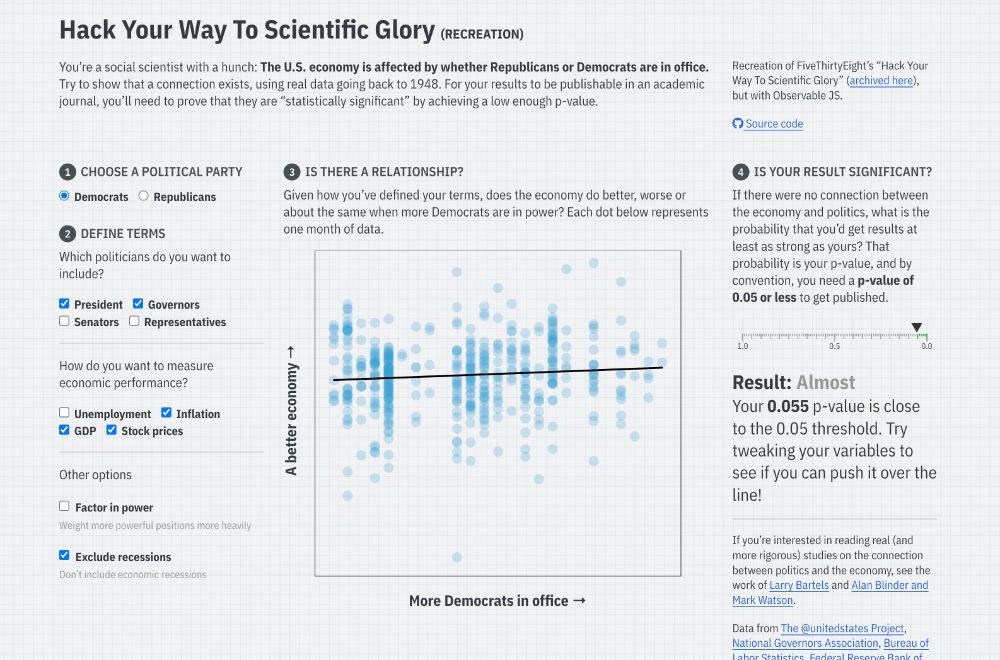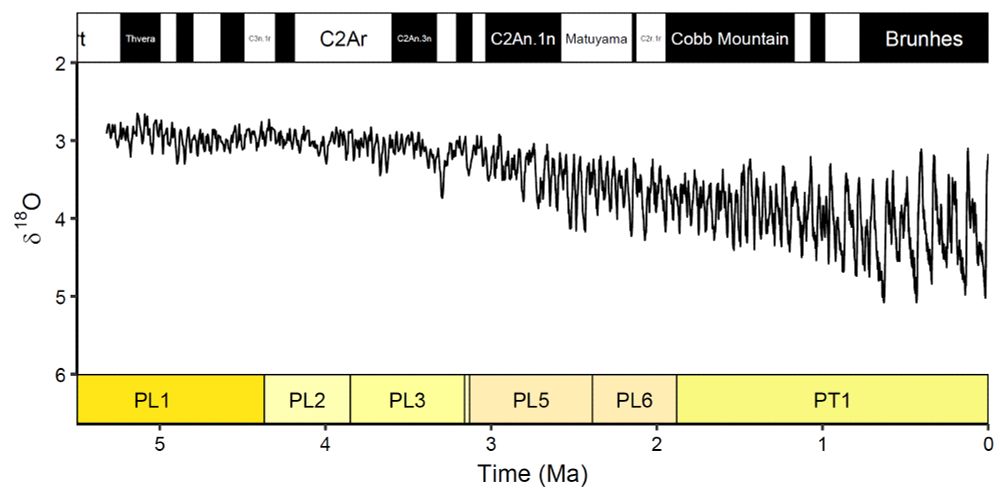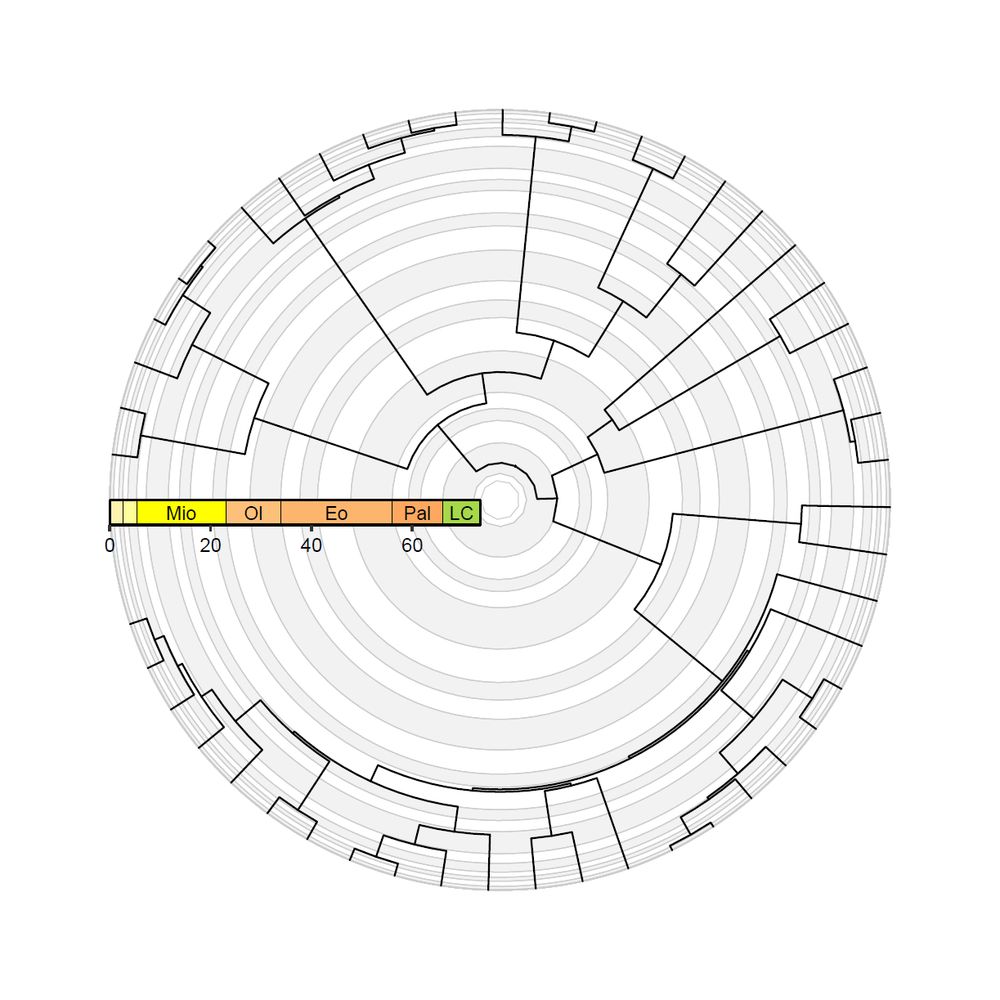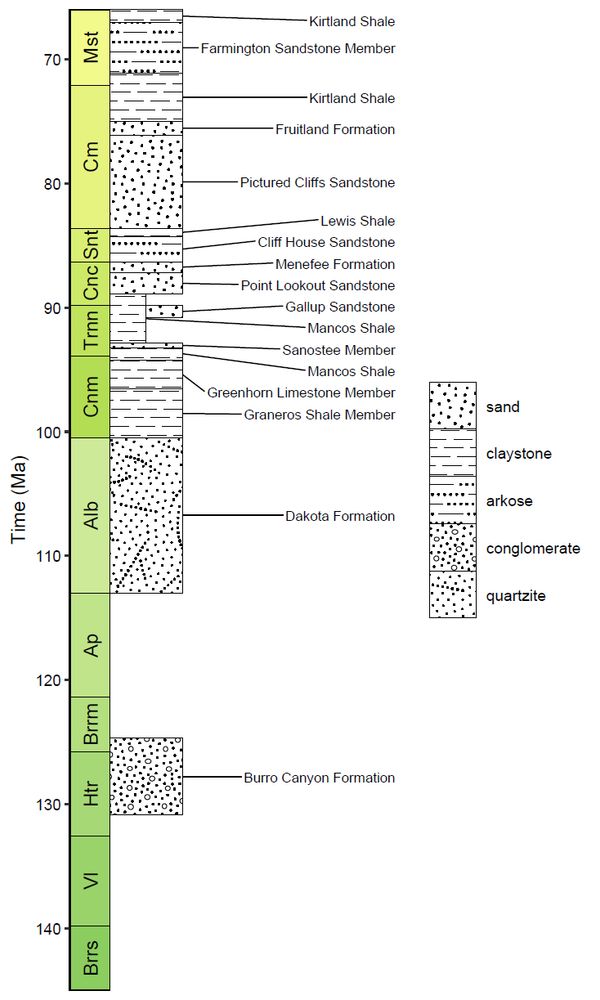
Screenshot of the linked Quarto website, with input checkboxes to change different conditions for a regression model that predicts economic performance based on US political party, with a reported p-value
I’ve long used FiveThirtyEight’s interactive “Hack Your Way To Scientific Glory” to illustrate the idea of p-hacking when I teach statistics. But ABC/Disney killed the site earlier this month :(
So I made my own with #rstats and Observable and #QuartoPub ! stats.andrewheiss.com/hack-your-way/
20.03.2025 18:30 — 👍 1468 🔁 439 💬 58 📌 30

Happy Ctenophore Day!
These glowing ocean drifters look like jellyfish but aren’t! They’re comb jellies, shimmering creatures that light up the sea with rows of beating cilia 💙🌈
Which species can you identify? 👀 Most are raised in @pawelburkhardt.bsky.social lab
#CtenophoreDay #CombJelly #Ctenophore
04.10.2025 18:21 — 👍 1841 🔁 298 💬 45 📌 12

A graphic that reads Happy Ctenophore Day in glowing pink text twice between three rows of different ctenophore species. The top row is lobate ctenophores including Bolinopsis microptera, Leucothea pulchra, Mnemiopsis leidy, and the bloody belly comb jelly Lampocteis. The second row has three different Beroe species. The lowest row has Pleurobrachia bachei, Dryodora glandiformis, red-x, and Euplokamis dunlapae.
Happy Ctenophore Day!
🐙🦑🧪
04.10.2025 07:36 — 👍 435 🔁 142 💬 6 📌 13

‘Earth system engineers’ and the cumulative impact of organisms in deep time
Understanding the role of humans as ‘ecosystem engineers’ requires a deep-time perspective rooted in evolutionary history and the fossil record. Howev…
When does biology become geology? This is a fun paper for us (although I, myself, was just one more member of Band-Aid for this particular paper), and hopefully it helps clarify a lot of things that we sort of already knew but never really formally addressed.
www.sciencedirect.com/science/arti...
23.09.2025 15:38 — 👍 39 🔁 14 💬 4 📌 0
Whaddaya mean, "how it was made"? They didn't just set up a camera and film some dinosaurs?
06.09.2025 08:34 — 👍 0 🔁 0 💬 1 📌 0
Do you know if the class action lawsuit covers only books, not research papers? As far as I can tell the work needs to have an ISBN, which seems to rule out papers, but I am not a lawyer.
06.09.2025 07:56 — 👍 1 🔁 0 💬 0 📌 0
The penguins cover is much better IMO.
30.08.2025 21:03 — 👍 1 🔁 0 💬 0 📌 0

facade of Martin Hall; one side is almost all a huge window

lower lever of a lounge in Martin Hall, with 2-story windows overlooking a nicely landscaped area

upper lever of a lounge in Martin Hall, with 2-story windows overlooking a nicely landscaped area

lounge in Martin Hall with sofas, tables, chairs, and ottomans, overlooking the Crum Woods
The new Martin Hall at @swarthmorecollege.bsky.social is spectacular
28.08.2025 12:37 — 👍 4 🔁 0 💬 1 📌 0
Do you know who the interviewer was? I don't see anyone credited by name.
21.08.2025 05:50 — 👍 1 🔁 0 💬 1 📌 0
Also, the ultimate unit (even more so than The Big Unit) is J. R. Richard.
20.08.2025 07:34 — 👍 0 🔁 0 💬 0 📌 0
The formula is 100*sqrt(p*(1-p)/n), where
n = the number of games (350), and
p = your true win% in decimal form (which is unknown, but you can use your best guess, 16.6% or .166).
Typical political polls have p near .50 and n around = 1000, which is how they get the ubiquitous ±3 margin of error.
20.08.2025 07:31 — 👍 0 🔁 0 💬 1 📌 0
@kentremendous.bsky.social @joeposnanski.com
I'm a longtime Poscast listener (since 1957) and statistics professor. Re: solitaire win%: at 350 games, the SD is 2%. Meaning 68% of the time, your win% will be accurate to within ±2%, and 95% of the time, your win% will be accurate to within ±4%.
20.08.2025 07:27 — 👍 0 🔁 0 💬 1 📌 0
I second this recommendation. I find this tutorial gives just enough but not too much detail, and I use it with students in my lab.
19.08.2025 12:37 — 👍 1 🔁 0 💬 0 📌 0
I think we also get distracted because we tend to anthropomorphize the larval stage as the child and the adult stage as the real animal. In some cases (not necessarily holothurians, but perhaps e.g. butterflies), it would be more appropriate to think of them as the eating stage and the mating stage.
18.08.2025 22:18 — 👍 10 🔁 3 💬 3 📌 0
Just listened to this, and I thought you were great. Love your enthusiasm!
19.08.2025 09:52 — 👍 0 🔁 0 💬 0 📌 0
I think we also get distracted because we tend to anthropomorphize the larval stage as the child and the adult stage as the real animal. In some cases (not necessarily holothurians, but perhaps e.g. butterflies), it would be more appropriate to think of them as the eating stage and the mating stage.
18.08.2025 22:18 — 👍 10 🔁 3 💬 3 📌 0

Plot of global benthic δ18O data for 0 – 5.3 Ma (Lisiecki & Raymo, 2005) with geomagnetic polarity subchrons displayed on the top x-axis and planktic foraminiferal primary biozones plotted on the bottom x-axis using the deeptime package.

A mammal phylogeny (Garland et al., 1992) plotted in the fan layout using the ggtree and deeptime packages. The greyscale concentric circles in the background indicate geological stages, whereas the linear colored timescale indicates geological epochs.

Early tetrapod occurrence data (Jones et al., 2023) plotted as a taxonomic/biostratigraphic range plot using the geom_points_range() function from the deeptime package.

A stratigraphic column of Cretaceous lithostratigraphic units from the San Juan Basin, USA. The deeptime package has been used to add pattern fill which indicate the primary lithologies of the units as reported by the Macrostrat API (Peters et al., 2018) via the rmacrostrat R package (Jones et al., 2024).
📢 deeptime: an R package that facilitates highly customizable and reproducible visualizations of data over geological time intervals
🔗 doi.org/10.1080/2096...
Fully #openaccess in @bigearthdata1.bsky.social with insight about deeptime📦 development and code examples!
#rstats #geology #paleontology
06.08.2025 13:06 — 👍 117 🔁 46 💬 3 📌 3
YouTube video by Out of the Main - Born at sea. Raised on radio.
Grant Geissman Interview: The Chuck Mangione years and more!
I've been gratified to read the outpouring of love for Chuck Mangione, who by all accounts seemed to be a kind and generous guy.
Fun fact: Mangione had a pension plan for his band members, which is unheard of in the music business. More info at 10:15 here: youtu.be/825UjdUH464
28.07.2025 13:12 — 👍 0 🔁 0 💬 0 📌 0
This was my favorite King of the Hill joke with Chuck Mangione. RIP, king.
24.07.2025 21:13 — 👍 94 🔁 24 💬 0 📌 2

Fossil of Falcatus falcatus, an ancient relative of sharks, showing a forward-facing spiny appendage coming out of the back of its head. Photo by H. Zell via Wikipedia.

Fossil of Stethacanthus, an ancient relative of sharks, showing its unusual anvil-shaped dorsal fin. Photo by JonasB 7 via Wikipedia.
This is so cool. I wonder if appendages in ancient shark relatives such as Falcatus and Stethacanthus could have had a similar function (although I believe these features are sexually dimorphic, so maybe not).
27.07.2025 21:30 — 👍 3 🔁 0 💬 1 📌 0
Land of Make Believe was my favorite as well, especially the epic performance on Live at the Hollywood Bowl.
27.07.2025 04:39 — 👍 0 🔁 0 💬 0 📌 0
My introduction was his 1984 concert to celebrate the 150th anniversary of Rochester, NY. It changed my life and made me a lifelong music lover.
www.youtube.com/watch?v=3sKP...
26.07.2025 12:48 — 👍 0 🔁 0 💬 1 📌 0
Land of Make Believe is my favorite, too. Love the version on Live at the Hollywood Bowl.
26.07.2025 10:47 — 👍 1 🔁 0 💬 1 📌 0
I grew up in Rochester during his commercial peak. I saw him play probably half a dozen times; he was a huge influence on me.
26.07.2025 10:42 — 👍 1 🔁 0 💬 1 📌 0
And he was a fantastic composer. His early pieces such as Land of Make Believe and Hill Where the Lord Hides were often an ambitious mix of pop, jazz, classical, and folk influences.
26.07.2025 10:27 — 👍 1 🔁 0 💬 0 📌 0
Brilliant. Love your left hand parts.
26.07.2025 10:23 — 👍 1 🔁 0 💬 1 📌 0
One of my favorite songs of his. Love the subtle and unexpected dissonance at 0:12.
26.07.2025 10:21 — 👍 1 🔁 0 💬 0 📌 0
My favorite as well, particularly the version from Live at the Hollywood Bowl.
26.07.2025 10:18 — 👍 0 🔁 0 💬 0 📌 0
Yes, my favorite as well. What a virtuoso acoustic guitar solo by Grant Geissman.
26.07.2025 10:12 — 👍 1 🔁 0 💬 0 📌 0
I write Cup of Coffee, a daily baseball, politics, entertainment, and nonsense newsletter: https://www.cupofcoffeenews.com/
🐚🪼Publishing research that uses systematics to advance palaeontology🐾🐟
📃Our papers:
https://www.tandfonline.com/journals/tjsp20
🏛️We're based at the Natural History Museum, London:
https://www.nhm.ac.uk/business-services/publishing/Journals
Neuroscientist at UW studying proprioception and motor control. Promoting the people and work in my lab (www.tuthill.casa). Also pursuing a snow fly side habit (www.snowflyproject.org).
A legacy of discovery. A future of innovation.
🇧🇷 Computational paleobiology, macroevolution, Bayesian phylogenetics, and canids 🐶
PhD candidate @ Iowa State University
brpetrucci.github.io
Paleobiologist | macroevolution | fossil coral and reef communities
PaleoSynthesis Postdoc @paleosynth.bsky.social @ FAU Erlangen-Nürnberg 🇩🇪 ECR Representative @ifcrs.bsky.social 🪸 she/her 🇷🇸
Semi-retired computer scientist, ancient UNIXer, "Big Data"
https://en.wikipedia.org/wiki/John_Mashey
Last 20 yrs: chasing anti-science disinfo, esp. on climate or tobacco, helping defend scientists.
Supporter of UCSF, CSLDF, NCSE, CSI, member AAAS, AGU.
Assistant Professor of Sociology, University of Michigan. Studying cities and inequality
Associate Professor in Evolutionary biology, Natural History Museum, University of Oslo | Phenotypic evolution along the timescale continuum.
The Palaeo@Leeds Research Group is a multidisciplinary group of palaeobiologists, climate modellers, and geochemists based in
the School of Earth and Environment at the University of Leeds.
Higher Ed | Believer in democracy, anti-fascism, and karma | Swiftie | ROC, NY | Feminist | Ally | Pro-choice | BLM
Biodiversity and extinction researcher
The podcast that explores the surprising secrets of curious people. Hosted by Rachael Moeller Gorman.
https://www.buzzsprout.com/2464891
https://socializingwithscientists.com/
🌍 Biologist, 🪺 Studying strange animal nests, 📚 Author, 🧠 Doing science communication daily, 🏛️ Loves natural history, 🔥 Documenting the Anthropocene 🌐 www.aukeflorian.nl
📍 Leiden, The Netherlands
PhD student at Uni Bayreuth, Germany
MSc in Palaeobiology/Geosciences at FAU, Germany
Working on extinction mechanisms and processes 🦕☄️
(she/her)
Astrophysics PhD, Baseball HOF, Baseball Deconstruction Expert, Data Scientist, Official Scorer, Superhero, Knitting Designer. Not necessarily in that order.
Signal: bbl_astrophyscs.94
Historian of Science, author, eukaryote, synth dabbler, Radical Leftist™
Father of Snakes, Sower of Chaos, the Elicitor | 🏳️🌈 ✡️ Paleontologist | PhD candidate at GWU studying squamate systematics, phylogeny, and biogeography
Yale SOM professor & Bulls fan. I study consumer finance, and econometrics is a big part of my research identity. He/him/his
















